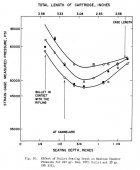Here is the essence of my question. Varying the OAL of a cartridge, either pushing the bullet into the rifling (jam) or holding it short (so that the bullet jumps to the rifling) is commonly used to fine tune accuracy. Can anyone tell me what is being affected by the change and how does that effect translate into a change in accuracy?
I can think of two general categories of effects;
Powder combustion
Bullet alignment
Some possibilities I have pondered;
Causing the rate of powder burn to increase or decrease
More complete ignition earlier in the combustion cycle
Higher pressure before bullet moves
Higher pressure before bullet moves significantly
Bullet is more centered in the bore
Bullet is free to self center
It is interesting too that the testing to determine optimum OAL is commonly performed after a primer/power/charge weight is determined. That would seem to indicate bullet alignment rather than powder charge as the mechanism.
Secondarily there is the question of why is it not universal? Sometimes, seemingly with everything else being the same, cartridge, powder, bullet, primer, charge etc. jamming or jamming harder improves accuracy while other times jumping is the answer. If I remember correctly, which happens less and less often, certain bullets are more likely to respond positively to jamming and some are more sensitive than others to jumping or jamming.
Most importantly you are timing the bullets exit at the most opportune time
much like timing an engine, you are "timing" the bullet to the specific harmonics of the barrels vibrations
Many consider tuning to a NODE to be the best
However if you tune it to where the bullet exits every time the barrel vibrates to its 12' oclock high position on the upswing of its vibration and it does it the same way every single shot, that is just as well and good.
But we really have no way to monitor or check this right?
We just call it tuning to a node.
a Node is a dulling point where most of the harmonics cancel each other out and the barrel should be at it's neutral point.
Whenever 2 frequency's are 180 degrees out of phase they cancel each other out.
There are 3rd haronics, 5th harmonics, 7th harmonics etc but the harmonics do not have as much amplitude as the 1st harmonic
But what if we tune our bullets exit to where at least the 1st, 3rd, and 5th harmonic are all 180 degrees out of phase............that would be quite a canceling out Node.
I've done some vibration testing and found nodes to be approximately ever 1" apart
That should give us the half wavelength of the barrels resonant frequency.
This gives us a Vibrational Freq. of approx 90Khz. (Quite high)
With the speed of sound in SS being approx 18,ooo fps this means the wave can travel back and forth end to end lets say 5 times before the bullets exits the bore
Every time the wave hits the end a standing wave is created which increases amplitude when 2 waves collide/crash against each other
The 2 waves colliding and increasing amplitude is where we DO NOT want the bullet to exit
What if this happens right when the bullet leaves the bore?
It will throw the bullet all over the place
This is why I have seen my rifles shoot 1.5" groups if the seating depth is wrong
... then tune in to .200" groups when it is right.
(Another reason why it is hard to find Factory Ammo that shoots good because there is no way it will be tuned to any specific rifle)
it's quite amaing to see a group shrink, tune in, then grow back out when the seat depth gets outside the tuning node.
However, there can be several Nodes or tuning points say .040" apart
Berger I read did some extreme seating depth testing and found about 3 nodes within .120" of seating depth
All if I remember starting .005" off the lands testing out to .140" jumping
---------------------------------
I have found
with non VLD type short or flat base bullets , always seat off the lands
With lonnnnng VLD Types such as Sierra Match Kings I have found jamming up to about .060" to work best
The ogive of a long VLD is so gradual that jamming .060" in is really not like slamming it against a wall
---
The rest is as you say, Seat deaper = builds quicker combustion which can build pressures quicker
Seating out allows more powder etc etc
This is not why most of us conduct seating depth tests, it is to find the node for highest accuracy











